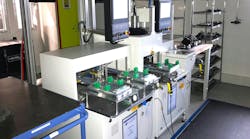WASHINGTON, 15 Feb. 2009. Leaders of the U.S. Naval Sea Systems Command in Washington are awarding a $3.5 million to General Dynamics National Steel and Shipbuilding Co. in San Diego to start designing the Mobile Landing Platform (MLP) ship, which will partially submerge in water so that cargo and smaller vessels can float on and off.
General Dynamics experts will help the Navy determine the amount of shipboard electronics necessary to operate the future MLP ship, as well as the kinds of shipboard electronic systems such as shipboard communications the MLP vessel will need to perform its mission.
The MLP ship also will link large cargo ships with smaller vessels that deliver cargo to bases to battlefield areas on the beach. The contract is for systems design part 1 (SD1), with an option for systems design part 2 (SD2).
"MLP will be a key, flexible ship asset for the Navy and Marine Corps," explains Navy Capt. George Sutton, program manager of the Strategic and Theater Sealift program within the Navy's Program Executive Office Ships.
MLP will provide the vehicle transfer system to move Marines, naval personnel, and equipment between the large, medium-speed, roll-on/roll-off ships (LMSR) to the MLP and smaller craft, and then to bases ashore.
An MLP will have two places for loading, launching, and recovering two landing craft-air cushioned (LCAC) vehicles near-simultaneously. It will carry as many as six LCACs, and have berthing for brigade forces.
The MLP will be able to travel at 20 knots, with a range of about 9,000 nautical miles. The Navy intends to build three MLPs -- the first to be delivered in 2015.
The MLP's self-contained ballast system controls submersion and lifting by lowering into the water by filling their ballast tanks with water, submerging the cargo deck of the ship. While the deck is submerged, the cargo is floated above it. Then the ship empties its ballast tanks and raises in the water to land cargo on the deck.


